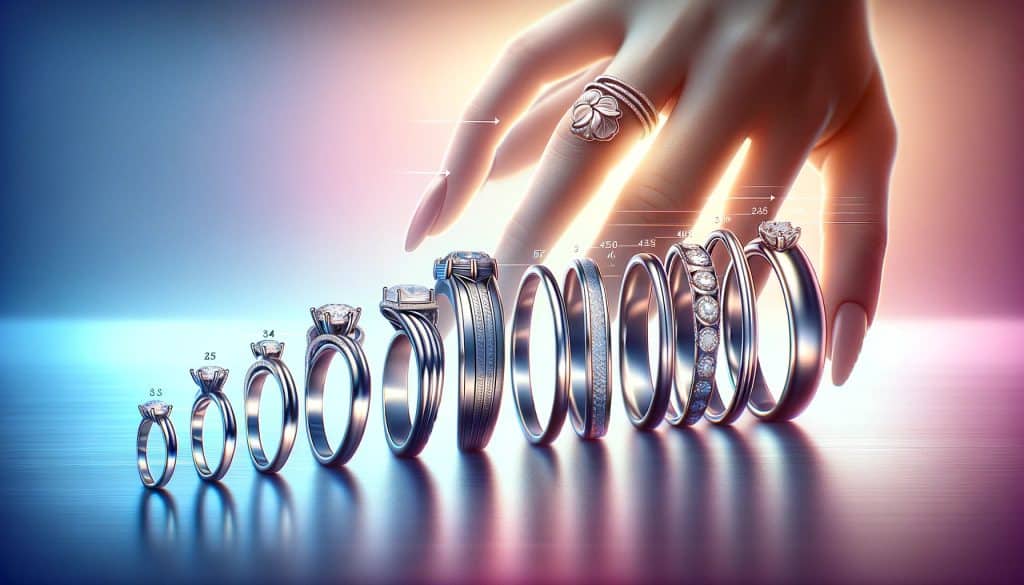When it comes to engagement rings, size isn’t just a number; it’s a symbol of how well you know and understand your partner. The right ring size is more than a comfort issue—it’s about making the perfect choice for a significant moment in your life.
Choosing an engagement ring is a journey filled with emotions, expectations, and sometimes, anxiety. It’s a delicate balance between personal taste, lifestyle, and practicality. After all, this ring isn’t just for a moment; it’s for a lifetime.
The size of the ring matters profoundly
It must fit just right, reflecting the thought and care put into its selection. It’s a physical representation of your commitment, sitting snugly on your loved one’s finger, a constant reminder of your bond.
As we delve deeper into this guide, we’ll explore the nuances of ring sizing, from the technicalities of measurements to the subtle considerations of comfort and style. We’ll equip you with the knowledge and tips you need to navigate this crucial aspect of ring selection.
Whether you’re planning a surprise proposal or choosing a ring together, understanding ring sizes will help you make an informed, loving choice—one that fits perfectly in every sense of the word.
< class="wp-block-separator has-alpha-channel-opacity"/>Understanding Ring Sizes
When you’re on the quest for the perfect engagement ring, understanding ring sizes is like learning a new language. It’s about understanding the subtle differences and unique characteristics that vary across regions.

Let’s start with a global perspective.
In the United States, ring sizes are typically measured in numbers, ranging from 3 to 13.5 for adults. Meanwhile, across the Atlantic, the United Kingdom uses a letter-based system that starts from G and goes all the way up to Z. Then there’s Europe, where ring sizes reflect the circumference of the finger in millimeters, ranging usually from 40 to 76.
Now, let’s dive into the nitty-gritty of how these sizes are determined. At its core, ring sizing is about two main measurements: the band circumference and the diameter.
The band circumference is the total length of the ring band, while the diameter measures the distance across the inside of the ring. These measurements are crucial because they ensure that the ring sits comfortably on the finger, neither too tight nor too loose.
Understanding the Measurement Systems
- U.S. Ring Size System
- Numerical values (e.g., 6, 7, 8).
- Often includes half and quarter sizes for a more precise fit.
- U.K. Ring Size System
- Alphabetical values (e.g., K, L, M).
- Includes half sizes.
- European Ring Size System
- Based on the inner circumference of the ring in millimeters.
- Provides a direct measurement of the finger’s girth.
How to Measure
- Band Circumference
- Use a flexible measuring tape or a piece of string.
- Wrap it around the base of the finger.
- Mark where the tape or string first overlaps.
- Measure the length against a ruler (for a string) or read off the tape measure.
- Diameter
- Use a ring that fits well.
- Measure across the ring’s inside from edge to edge.
- Ensure the measurement is central.
Understanding ring sizes in different regions is like translating a universal language of love and commitment. It’s about ensuring that the ring you choose not only symbolizes your bond but also fits perfectly in the cultural context of where you are.
Whether you’re in the bustling streets of New York, a quaint English village, or a romantic European city, the language of ring sizes helps bridge your love story with the traditions and norms of your locale.
< class="wp-block-separator has-alpha-channel-opacity"/>The Basics of Measuring Your Ring Size
Finding the right ring size might seem like a complex task, but it doesn’t have to be. With some simple DIY methods and a few key tips, you can get a good estimate of your ring size right at home.
Of course, there’s always a place for professional sizing, especially when you’re looking for that perfect fit. Let’s explore both worlds.

DIY Methods for Home Measurement
- String Method
- Wrap a thin string or a strip of paper around the base of your finger.
- Mark where the ends meet with a pen.
- Measure this length against a ruler.
- Compare the measurement to a ring size chart to find your size.
- Printable Ring Sizer
- Download and print a ring size chart from a reliable jeweler’s website.
- Place a ring that fits well over the circle sizes on the chart to find your size.
- Using a Ring You Own
- Place an existing ring on a ruler.
- Measure the inside diameter.
- Compare the measurement to a ring size chart.
Importance of Professional Sizing
While DIY methods are a great start, nothing beats the accuracy of professional sizing. Here’s when you should consider seeking a jeweler’s expertise:
- When you’re planning a surprise proposal and want to ensure the perfect fit.
- If you have larger knuckles or irregular finger shapes, which might require a more tailored approach.
- When purchasing a high-value ring, as the cost of a mistake could be high.
Tips for Accurate Measurements
- Temperature Considerations
- Avoid measuring when your body temperature is too hot or cold, as fingers can swell or s ink.
- The best time to measure is when your body is at a normal temperature, typically in the evening.
- Time of Day
- Measure your finger at the end of the day, when it is likely to be at its largest size.
- Avoid measuring in the morning or after exercising.
- Multiple Measurements
- Take several measurements at different times to ensure accuracy.
- If you find different sizes, choose a size that’s a comfortable median.
By understanding these basics of ring sizing, you’re well on your way to ensuring that the engagement ring you choose or receive isn’t just a symbol of your love, but also a comfortable, perfect fit.
Whether you’re wrapping a string around your finger or sitting down with a professional jeweler, remember, it’s all part of the exciting journey towards one of life’s most beautiful moments.
< class="wp-block-separator has-alpha-channel-opacity"/>Ring Size and Comfort
When it comes to engagement rings, finding the right size is just part of the equation. Comfort is equally important. After all, this ring isn’t just for special occasions; it’s meant to be worn every day.
The fit of the ring is influenced by various factors, from the shape of your finger to your daily activities. Let’s delve into how band width, finger shape, lifestyle, as well as different styles and materials, can impact both ring size and comfort.

Factors Affecting Ring Fit
- Band Width
- Wider bands typically require a larger size as they cover more of the finger.
- Narrower bands can be more forgiving and may fit more comfortably on various finger types.
- Finger Shape
- Tapered fingers (wider at the base) might need a snug fit to prevent the ring from sliding off.
- Straight fingers can accommodate a range of fits but may require tighter sizing for wider bands.
- Lifestyle Considerations
- If you’re active or work with your hands, a snugger fit may prevent the ring from catching or slipping.
- Consider the ease of removal if your fingers often swell due to work or health conditions.
Impact of Styles and Materials
- Ring Styles
- Solitaire rings with a single stone are often easier to size and might offer more comfort for daily wear.
- Rings with intricate designs or multiple stones might feel bulkier and could affect sizing.
- Materials
- Softer metals like gold are more prone to bending and can alter the fit over time.
- Durable materials like platinum maintain their shape better, ensuring a consistent fit.
- Setting Type
- A high-set stone might catch on clothing and might feel less comfortable for daily wear.
- Lower profile settings are less intrusive and can be more comfortable for active lifestyles.
Balancing Size and Comfort
The key to balancing ring size and comfort lies in understanding these factors and how they relate to your personal circumstances. For instance, if you have a job that requires manual labor, you might prefer a sturdier band and a lower profile setting for both comfort and practicality. Or, if you have tapered fingers, you might lean towards a design that stays securely in place.
So as you can see, while the aesthetic of an engagement ring is undoubtedly important, never underestimate the significance of comfort and fit. The perfect ring should feel like a natural extension of yourself, beautifully encapsulating both your style and your daily life.
When these elements align, not only does the ring look stunning, but it also feels right – a constant, comfortable reminder of the love it represents.
< class="wp-block-separator has-alpha-channel-opacity"/>When to Adjust Ring Size
Engagement rings, much like the relationships they symbolize, need to adapt and change over time. It’s not just about the initial fit; it’s about how the ring continues to fit t ough various life stages and seasonal changes.
Understanding when and why to adjust ring size can save you from discomfort and ensure your ring always feels like part of you.

Life Changes Affecting Finger Size
- Weight Fluctuations
- Gaining or losing weight can significantly change finger size.
- It’s common to need a ring resizing after major weight changes.
- Pregnancy
- Many women experience swelling in their fingers during pregnancy.
- Temporary solutions like ring adjusters can accommodate these changes.
- Aging
- As we age, our fingers can change size due to variations in skin elasticity and joint sizes.
- Regular check-ins with your jeweler can ensure a comfortable fit t oughout the years.
Seasonal Changes and Finger Size
- Warm Weather
- Fingers can swell in hotter temperatures or in humid conditions.
- It’s wise to avoid resizing during summer as it might lead to a too-tight fit in cooler months.
- Cold Weather
- Fingers often s ink in colder weather.
- If your ring feels loose in winter, consider temporary solutions like ring sizers rather than permanent resizing.
When to Consider Resizing
- Persistent Discomfort
- If the ring consistently causes discomfort, it’s time to resize.
- Remember, comfort is key to wearing your ring with joy every day.
- Difficulty in Wearing or Removing
- If putting on or taking off the ring becomes a struggle, it’s a clear sign for resizing.
- Ring Slippage
- If the ring frequently slips or spins, it’s too loose, risking loss or damage.
Resizing is a common and essential part of owning an engagement ring. It’s not just about maintaining the ring’s beauty; it’s about ensuring it continues to fit your evolving life.
Like any lasting relationship, it requires attention and occasional adjustments to keep it strong and resilient. Always remember, the perfect fit today might need a tweak tomorrow, and that’s perfectly normal.
< class="wp-block-separator has-alpha-channel-opacity"/>Custom Sizing Options
Engagement rings are as unique as the fingers they adorn, and sometimes, off-the-shelf sizes just don’t cut it. This is where custom sizing comes into play. It’s about tailoring the ring to fit the unique contours of your finger, ensuring comfort and security.
Whether you have tapered fingers, large knuckles, or an irregular finger shape, custom sizing options can accommodate your needs.

Tailoring for Unique Finger Shapes
- Tapered Fingers
- Rings can easily slide off tapered fingers.
- Custom sizing can include wider bands or sizing beads to prevent slipping.
- Large Knuckles
- Getting a ring over a large knuckle can be a challenge.
- Hinged or split shank rings can open to fit over the knuckle and then close for a snug fit around the base of the finger.
- Irregular Shapes
- For fingers with unique bends or curves, custom-molded rings can provide the perfect fit.
- Computer-aided design (CAD) technology helps in creating a ring that contours exactly to your finger shape.
Options for Resizing Rings
- Adding or Removing Metal
- Common for bands that are too loose or too tight.
- Suitable for small adjustments but can alter the ring’s design if drastic changes are needed.
- Stretching
- Suitable for minor increases in size, typically half a size.
- Not recommended for rings with intricate designs or stones, as it can distort the setting.
- Sizing Beads
- Small metal beads added to the inside of the band to reduce size.
- Ideal for fingers with large knuckles, as they allow the ring to slide over the knuckle but fit snugly at the base.
Limitations of Resizing
- Design Integrity
- Some designs, especially those with intricate detailing or stones set around the band, can’t be resized without affecting their appearance.
- Material Constraints
- Materials like tungsten or titanium are difficult or impossible to resize.
- Frequency of Resizing
- Frequent resizing can weaken the band and potentially harm the ring’s structure.
Custom sizing options ensure that your engagement ring is not just a symbol of your commitment but also a perfect fit for your unique finger. It’s about personalizing the ring to match not only your aesthetic preferences but also your physical requirements.
This tailored approach ensures that your engagement ring is as comfortable to wear as it is beautiful to behold. Remember, a ring that fits well is a ring that’s worn well, symbolizing the lasting and adaptable nature of your love.
< class="wp-block-separator has-alpha-channel-opacity"/>Special Considerations for Different Ring Styles
When choosing an engagement ring, the style and setting play a significant role in not just aesthetics but also in sizing and fit. From the minimalist elegance of a solitaire to the intricate beauty of a halo setting, each style brings its own sizing considerations.
And let’s not forget the gemstones, which are much more than just sparkling adornments—they influence how a ring fits on your finger.

Impact of Ring Settings on Sizing
- Solitaire Rings
- Characterized by a single stone, usually with a simple band.
- Easier to resize due to the lack of complex details.
- Comfortable for daily wear and less prone to catching on clothing.
- Halo Rings
- Feature a center stone surrounded by smaller diamonds or gemstones.
- The intricate setting can make resizing more complex.
- The added stones can make the ring feel bulkier, affecting comfort.
- Band Style Rings
- Include designs like eternity bands where stones go around the entire band.
- Resizing can be challenging or impossible without disrupting the stone placement.
The Role of Gemstones in Fit
- Size and Shape of the Stone
- Larger stones can make a ring top-heavy, causing it to spin if not sized correctly.
- The shape of the stone (like marquise or oval) might require specific band adjustments for a balanced fit.
- Setting of the Stone
- High settings can catch on clothing and may feel uncomfortable during certain activities.
- Lower settings are more practical for active lifestyles but require precise sizing to ensure security.
- Multiple Stones
- Rings with multiple stones, like t ee-stone settings, can feel wider and may need a larger size.
- The distribution of stones affects the ring’s balance on the finger.
Sizing Tips for Different Styles
- Consider Lifestyle
- If you lead an active lifestyle, opt for styles that are less prone to catching and easier to maintain.
- Balance Aesthetics and Comfort
- While style is important, ensure it aligns with comfort and practicality.
- Future Resizing
- Some styles offer limited resizing options, so consider long-term wearability.
Different ring styles and settings are not just expressions of personal taste; they are practical considerations that impact daily wearability.
The right fit goes beyond mere size—it’s about how the ring sits on your finger, how it moves with you, and how it stands the test of time and activity. By understanding these special considerations, you can choose a ring that’s not just visually stunning but also a perfect fit for your lifestyle and finger.
< class="wp-block-separator has-alpha-channel-opacity"/>Caring for Your Sized Ring
A well-fitted engagement ring is a treasure, and like any valuable item, it requires proper care and maintenance. Ensuring the longevity of your ring is not just about preserving its beauty; it’s about maintaining its fit and comfort over the years.
Here’s how you can take care of your ring to keep it looking and feeling as perfect as the day you first put it on.

Maintenance Tips for Longevity
- Regular Cleaning
- Gently clean your ring with a soft toothbrush and mild soap.
- Avoid harsh chemicals that can damage the metal or gemstones.
- Safe Storage
- Store your ring in a fabric-lined jewelry box when not wearing it.
- Keep it away from other jewelry to prevent scratches.
- Avoiding Damage
- Remove your ring during activities that could damage it, like heavy lifting or gardening.
- Protect it from extreme temperatures and harsh environments.
Knowing When to Resize or Check Your Ring
- Annual Check-ups
- Just like a health check-up, take your ring to a jeweler annually for inspection.
- The jeweler can check for loose stones, worn prongs, and any structural issues.
- After Significant Life Changes
- Consider resizing after major life events like weight changes, pregnancy, or health conditions that affect your finger size.
- If the Ring Feels Different
- If your ring starts to feel tighter, looser, or just different, it might be time for a check-up.
- Don’t wait until it’s too late, as a poorly fitting ring can be lost or cause discomfort.
Protecting Your Investment
- Insurance
- Consider insuring your ring against loss, theft, or damage.
- Keep all documentation, including resizing and repairs, for insurance purposes.
- Professional Advice
- For any concerns, always consult with a professional jeweler.
- They can provide tailored advice based on your ring’s style and material.
Caring for your sized ring is a commitment, much like the relationship it symbolizes. Regular maintenance and timely check-ups can prevent many common issues. Remember, this ring is not just a piece of jewelry; it’s a symbol of love and commitment, and it deserves to be treated with care and respect.
By following these simple tips, you can ensure that your engagement ring remains a beautiful and fitting symbol of your bond for years to come.
< class="wp-block-separator has-alpha-channel-opacity"/>Common Mistakes to Avoid
Selecting the right ring size can be a tricky process, and it’s easy to fall into common pitfalls. Being aware of these mistakes can save you from discomfort and the hassle of resizing. Let’s explore the most frequent errors people make when choosing ring sizes and provide some practical tips to avoid them.

Common Sizing Errors
- Guessing the Size
- Many people guess ring sizes, leading to poor fits.
- Avoid surprises that might not be pleasant—get sized properly.
- Not Considering Finger Shape
- Fingers aren’t just sizes; they have shapes and sizes that affect fit.
- Tapered fingers, large knuckles, and other unique features require special consideration.
- Ignoring Seasonal Changes
- Fingers can swell in heat and s ink in cold.
- Don’t size a ring during extreme weather conditions.
- Forgetting Lifestyle Factors
- Active lifestyles can affect how a ring fits and feels.
- Consider how daily activities might influence your ring’s comfort and security.
Tips to Avoid Mistakes
- Get Professionally Sized
- Visit a jeweler to get an accurate measurement.
- Consider getting sized more than once for consistency.
- Account for Finger Shape
- Discuss any unique finger traits with your jeweler.
- Consider custom sizing options if you have non-standard finger shapes.
- Plan for Flexibility
- If you’re between sizes, choose the larger size for comfort.
- Explore adjustable features or easily resizable designs.
- Monitor Fit Over Time
- Be aware of changes in your finger size over the years.
- Get your ring checked and resized as needed.
Resizing Considerations
- Material Matters
- Some materials, like tungsten, can’t be resized.
- Choose a material that allows for future adjustments if necessary.
- Design Limitations
- Certain ring designs are more challenging to resize.
- If you’re drawn to a complex design, discuss resizing options before purchase.
Avoiding these common mistakes isn’t just about ensuring a good fit; it’s about making sure your engagement ring is as comfortable and as meaningful as it is beautiful.
By taking the time to understand sizing and considering these tips, you can make a more informed choice that leads to a lifetime of comfortable wear. Remember, an engagement ring is a symbol of your love, and it should fit your finger—and your life—perfectly.
< class="wp-block-separator has-alpha-channel-opacity"/>Conclusion
Finding the perfect size for an engagement ring is a journey filled with careful consideration and attention to detail.
It’s about more than just a number on a scale; it’s about finding a piece that fits comfortably, looks beautiful, and symbolizes the love and commitment you share. Here’s a recap of the key points to remember:

- Understand Different Sizing Systems
- Ring sizes vary globally, so familiarize yourself with the sizing standards in your region, whether it’s the numerical system in the US, the alphabetical system in the UK, or the metric system in Europe.
- Measure Accurately
- Use reliable methods, whether DIY or professional, to ensure accurate sizing. Remember, factors like temperature and time of day can affect your finger size.
- Consider Ring Style and Material
- Different styles and materials can impact how a ring fits and feels. Your lifestyle and daily activities should also influence your choice.
- Be Mindful of Life Changes
- Your finger size can change due to factors like weight fluctuations, pregnancy, and aging. Seasonal changes can also affect how your ring fits.
- Prioritize Comfort and Maintenance
- A well-fitted ring is a joy to wear. Regular cleaning, safe storage, and periodic check-ups with a jeweler can maintain both its beauty and fit.
- Embrace Flexibility and Adaptability
- Your ring may need resizing or adjustments over time. Be open to these changes as they reflect the evolving nature of your life and relationship.
As you embark on this significant step, take your time and approach each aspect with care. An engagement ring is a symbol of your unique bond, and its size should reflect not only the dimensions of your finger but also the depth of your connection.
Remember, the perfect fit in a ring, much like in a relationship, is about comfort, suitability, and a sense of belonging. So, take a deep breath, enjoy the process, and let your journey to finding the perfect ring size be a memorable part of your love story.


